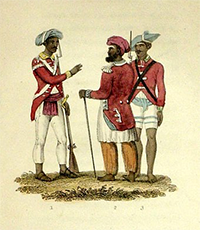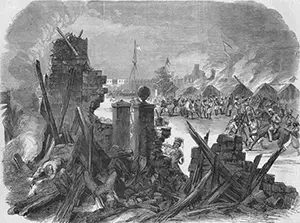The Sepoy Rebellion
The Sepoy Rebellion was an armed uprising of Indian soldiers against their British counterparts in the mid-19th Century that resulted in hundreds of thousands of deaths, military and civilian. 
The East India Company, established by royal charter in 1600, had expanded its muscle in India for more than two centuries, moving from a trade organization to a territorial authority. The EIC employed British and Indians as soldiers to defend the company's assets. In 1806, a number of sepoys serving at Fort Vellore were offended by changes in the dress code while on duty. In particular, Hindus could not wear religious marks on their foreheads and Muslims were told to trim their moustaches and shave off their beards. The last straw was the requirement to wear on the head not a traditional turban but a round hat that looked so very Christian-European. Most of those who voiced their disapproval were shipped out to another fort; a few were publicly whipped and forced to beg the EIC for forgiveness. The following year, sepoys in the hundreds rose up against the rest of the garrison at Fort Vellore. The uprising turned violent, and hundreds of British soldiers lay dead. The British had superior numbers and contained the uprising, which lasted all of a day, and then executed or deported the leaders of the uprising. Unhappy with all of it, the EIC replaced the governor of Madras as well. Fifty years later, another altogether more serious uprising occurred, with a much higher death toll and more other wide-ranging consequences. The advancement of gun technology was such in the late 1850s that the EIC soldiers were using a new type of cartridge for their Enfield rifles. A soldier using such a gun slid the cartridge down the barrel of the rifle in order to reload, and the cartridges were wrapped in grease-coated paper to make it easier to get the cartridge down the barrel. A rumor went around in 1857 that the grease that was used to coat the paper came from cows and pigs. The Indian soldiers were known as sepoys, and most of them were either Hindu or Muslim. Their religious beliefs prohibited them from touching such animals, and so if they had to handle the grease-coated paper that encased the rifle cartridges, then they would be touching cow or pig grease and so doing something that was against their religion. Making this rumor a bit more believable were the aggressive tactics of Christian missionaries, who had come to India in ever greater numbers, giving rise to yet another rumor, that the British intended to make India a Christian country. A large number of Indian soldiers refused to use the new cartridges and, in fact, took up arms against the British. The Sepoy Rebellion is known by other names, including the Sepoy Mutiny and the Indian Revolt of 1857. At that time, the number of sepoys in the British Army was about 300,000. The number of British in the British Army at that time was about 50,000. (Britain had pulled a large part of its Indian force away to fight in the Crimean War.) Another undercurrent that played a part in the sepoys' decision to rebel was the "doctrine of lapse," employed with gusto by Governor-General Lord Dalhousie, who wanted to gain more assets for the East India Company. At the time, many Indians owned large swathes of land. The common practice was for a landowner to pass his land on to his heir(s). Dalhousie's "lapse" policy stipulated that if a landowner who died without an heir, then the EIC became the heir and took over the land. He made it even more effective by later preventing an heirless landowner from naming one. Yet another fear that many sepoys had was being shipped overseas. A new Enlistment Act in 1856 nominally required all serving sepoys to respond if called to fight in another country. The EIC, which introduced the act, said that it intended to employ only new recruits in such a capacity; however, a large number of existing soldiers, fully aware that the Crimean War was going on relatively not far away, feared that they were about to get shipped off to another part of the world. 
The rebellion began with small acts of disobedience and escalated into large acts of violence. The first concentrated action took place on May 10 in Meerut. A few weeks before, members of the 3rd Light Cavalry stayed away from a firing drill to test the new rifles. The result was court-martial, and all others troops in Meerut were summoned to stand by and watch as the court-martialed troops were marched off to prison. The following day, the rebellion began. It began with violence, after which 50 men, women, and children lay dead. Uprisings followed in other cities, including Agra, Cawnpore, Gwalior, and Lucknow. The British could not respond right away because they were outnumbered and because, with the exception of Meerut, they had no idea: Sepoys had cut the telegraph lines. 
The sepoys, their numbers swelling by the day, marched to Delhi and took control of the city. The British, once they got organized, responded with a three-month siege and had to rely on heavy artillery to break through the thick stone walls around the city; once the invaders were inside, the fighting went street to street and resulted in heavy casualties on both sides, including civilians. And that was just Delhi. Advances against other sepoy-held cities commenced, with fighting stretching on for more than a year. It wasn't until July 8, 1858 that peace was declared. By that time, the U.K. Government had replaced the EIC with the British Raj. Most of the sepoys who rebelled were Hindu, although the number of Muslims in rebellion was not small. As well, Sikhs fought on the side of the British in this conflict because of enmity toward sepoys. One of the more famous of the sepoys who rebelled was Mangal Pandey, who rose up against his commanding officer, even firing at him, and ultimately gave his life for the cause. The ways in which soldiers, captive or not, were tortured and killed in this conflict included some particularly savage activities. One of those, which the British soldiers adopted after seeing the reigning Mughal Empire do it some years before, was to tie a captured soldier to the front of a cannon and then light the fuse. In all, 6,000 Europeans died in the fighting. The death toll of the native population was much, much higher, primarily as a result of a famine that resulted in part from all of the fighting. Estimates are that as many as 800,000 Indians died directly or indirectly because of the Sepoy Rebellion. Much of that number of dead was due to the British practice of not always discriminating between soldiers and civilians. The rebelling sepoys had done the same sort of thing when they had seized cities, but the number of Indian civilians was much higher than the number of British civilians. In the province of Oudh, the death of 150,000 Indians included 100,000 civilians. By the time the fighting stopped, both sides were willing to work together. Rather than carry out more reprisals, the British listened more than ever to the Indians for how best to rebuild and support the country. |
|
Social Studies for Kids
copyright 2002–2026
David White




